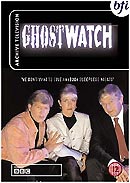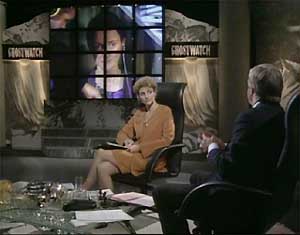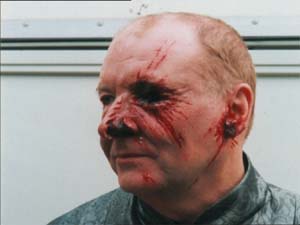 |
GHOSTWATCH
Director: Lesley ManningStarring: Michael Parkinson, Sarah Greene, Mike Smith, Gillian Bevan
Although billed as a drama in the Radio Times, the producers set out to deceive, and did catch out many viewers, who thought that they were watching a genuine documentary. This resulted in a similar public reaction to that which met Orson Welles’ infamous War of the Worlds radio broadcast, more than fifty years earlier. Ghostwatch originally appeared in a season of Screen One plays, and that strand's brief title sequence originally preceded the programme. Sadly this ident has been removed for the DVD release, which means viewers won't have the chance to see Ghostwatch in its original context. Frankly this is to be expected of some lesser labels, but you'd think that the BFI would have more sense! The play still has a caption card at the beginning, which credits the play’s writer, Steven Volk - something that was imposed on the producers by nervy BBC management - but if casual viewers had so much as blinked, they would probably have missed it! It’s virtually impossible to come to the play without preconceptions that undermine its effectiveness. Even viewers who still don’t know it’s fiction might twig when they see a couple of now relatively well know character actors (Gillian Bevan and Brid Brennan) in their roles as the TV pundit and distraught mother respectively. Despite this, it’s hard not to get caught up in what you see unfolding, and more than once or twice there are sharply chilling moments.
The disc also contains DVD Rom bonus materials: Volk’s original 1991 treatment, the screenplay and a short story written by Volk, Three Fingers, One Thumb, (which originally appeared in Samhain magazine, in 1998). The disc also comes with a booklet with sleeve notes by Kim Newman. The controversial aspects of the programme are broadly touched upon in the commentary, but there’s very little tangible evidence of the storm of protest that was unleashed on the disc itself (it made the front page of the next day’s newspapers, apparently caused several women to go into labour, and allegedly caused the suicide of a mentally retarded eighteen year old boy). The BFI have certainly missed a trick or two by not including some of the clips and trailers that are alluded to in the commentary (viewer reaction on Points of View and Biteback, for example), which reduce the disc’s value as a comprehensive document of the production. The programme itself is presented on a dual-layer disc, and probably looks as good now as it did when it originally beamed into viewer’s homes. There’s a slight softness to the picture and a mild graininess, but these are characteristic of BBC programmes of that era. The play was an early BBC stereo production, and, although it has a deliberate fly-on-the-wall character, has some decent separation effects, and good fidelity. The sound plays an important role in the production, and is generally very effectively used. The disc is very nicely authored. The menu screens are appropriately atmospheric, and the layer change is handled perfectly, (it’s at the junction of chapters nine and ten, and is only really noticeable when the viewer is listening to the commentary track). Fans of Ghostwatch have been badgering the BBC to get it released on video for almost a decade, so the BFI is to be congratulated for finally grasping the nettle, and achieving what the BBC itself was unwilling to do. It’s perhaps not the lavish bells-and-whistles toy-box that its fans had wished for, but it’s a solid package that none of them will be disappointed with. |


 Originally
broadcast on Hallowe’en night, 1992, Ghostwatch was a
ninety-minute play designed to unfold, documentary- style, in real-time,
like an episode of Crimewatch.
Originally
broadcast on Hallowe’en night, 1992, Ghostwatch was a
ninety-minute play designed to unfold, documentary- style, in real-time,
like an episode of Crimewatch.  The
disc comes with an excellent commentary track, by Volk, director Lesley
Manning and producer Ruth Baumgarten. They reveal all sorts of interesting
trivia and background information. You’ll discover, for example, that
there were demarcation problems at the BBC that dictated that the
producers could use studio facilities or outside-broadcast facilities, but
not both, and that the unusual format caused some problems for some of the
actors, who weren’t as adept at freewheeling as live broadcast veterans
like Sarah Greene and Michael Parkinson. (Parkinson, incidentally, is
quite excellent, never over-performing his role as show host and the
viewer’s touchstone). Volk is well versed in the genre, and freely
acknowledges many influences, including Nigel Kneale’s superb
The
disc comes with an excellent commentary track, by Volk, director Lesley
Manning and producer Ruth Baumgarten. They reveal all sorts of interesting
trivia and background information. You’ll discover, for example, that
there were demarcation problems at the BBC that dictated that the
producers could use studio facilities or outside-broadcast facilities, but
not both, and that the unusual format caused some problems for some of the
actors, who weren’t as adept at freewheeling as live broadcast veterans
like Sarah Greene and Michael Parkinson. (Parkinson, incidentally, is
quite excellent, never over-performing his role as show host and the
viewer’s touchstone). Volk is well versed in the genre, and freely
acknowledges many influences, including Nigel Kneale’s superb
 The
disc also contains Shooting Reality, a seven-minute examination of
Lesley Manning’s annotated script and other production documents,
explaining the logistics of such a complex drama. It also contains a very
rare shot of one of Caroline Noble’s very effective make-ups, and some
of the newspaper articles featured in the play.
The
disc also contains Shooting Reality, a seven-minute examination of
Lesley Manning’s annotated script and other production documents,
explaining the logistics of such a complex drama. It also contains a very
rare shot of one of Caroline Noble’s very effective make-ups, and some
of the newspaper articles featured in the play.